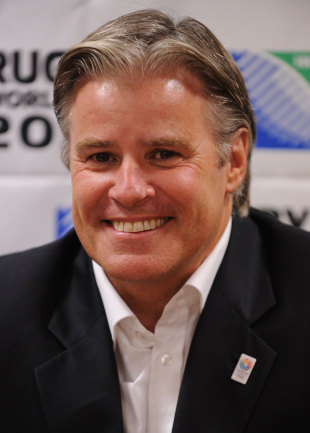|
Super Rugby
Gosper backs video ref for World Cup
April 22, 2013

IRB chief executive Brett Gosper believes the use of video adds to the game as a spectacle
© Getty Images
Enlarge
Protocols governing the use of the video referee in Super Rugby are likely to become adopted world-wide, says International Rugby Board (IRB) chief executive Brett Gosper. Gosper is a fan of the increased use in technology which allows the Television Match Official to go back up to two phases prior to the ball being grounded to determine whether a try has been scored. Referees, prompted by assistant referees or not, can also ask for the TMO to advise on incidents of foul play or request that it be shown on the big screen in the stadiums so they can rule on it. "I think the use of technology to get a fairness in outcome, if it's done the right way, is brilliant," Gosper said. "The trials have shown that it's been appreciated across the globe where it's been implemented." He acknowledged there had been some early teething problems when the process was first trialled in the English premiership and South Africa's Currie Cup competitions. "It took sometimes a little bit longer than you would have liked it to have taken. But the [two] phases of play is the one that's going to be rolled out. It's been very successful, really great for the game. If it's done properly the spectators enjoy it. It becomes part of the spectacle." The IRB chief also expects the protocols will be in use at the next IRB World Cup in England in 2015. He said criticism that the use of video technology slowed the game up was unfounded. "In the studies that we've done on it in the trialling it actually hasn't taken an enormous amount of time," he countered. Certainly from the public point of view, the fairness trade-off was worth taking." But Gosper does not see the technology being extended to include the goalposts. During the 2011 World Cup there was controversy surrounding a penalty kick by Wales' James Hook in the loss to South Africa. Hook thought his potential match-winning kick had gone inside the upright but it was deemed not to have done so by the referee and his assistants. "Goal technology we've throw away because we've got referees that do all of that," Gosper said. "I think this TMO takes it to a very good place. I don't think we're looking to get beyond that." There could be further changes to the scrum engagement in the near future however, following a trial that has just taken place during the recently completed Pacific Rugby Cup. The scrum continues to blight on the game at the elite level, with numerous collapses and resets that spoil the game as a spectacle. That Pacific tournament, featuring the second-string sides of Fiji, Samoa, Tonga and Japan and the development teams from New Zealand and Australia Super Rugby franchises, saw the front rows of scrums bind instead of just touch during the three-prong engagement call. "It seems the new engagement, which is a three-step process where the bind is held - crouch, bind, set - has reduced the impact of the scrum in the front row by about 25 percent," Gosper said. "It's therefore created a lot of stability in the scrum. It seems that in the tests there were higher scrum completions because of that and the players and referees all felt very comfortable about that." A global trial of the new "crouch, bind, set" engagement will be put to the vote at the IRB Council meeting in May. If it passes it could be introduced into this year's ITM Cup and be used in the November Tests as well. © Sportal
|
Live Sports
Communication error please reload the page.
-
Football
-
Cricket
-
Rugby
-
- Days
- Hrs
- Mins
- Secs
F1 - Abu Dhabi GP
Abu Dhabi Grand Prix December 11-131. Max Verstappen ()
2. Valtteri Bottas (Mercedes)
3. Lewis Hamilton (Mercedes)
4. Alexander Albon ()
5. Lando Norris ()
6. Carlos Sainz Jr ()
-
ESPNOtherLive >>
Golf - Houston Open
Snooker - China Open
Tennis - Miami Open

